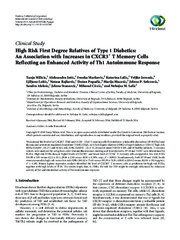Please use this identifier to cite or link to this item:
https://rfos.fon.bg.ac.rs/handle/123456789/1264Full metadata record
| DC Field | Value | Language |
|---|---|---|
| dc.creator | Miličić, Tanja | |
| dc.creator | Jotić, Aleksandra | |
| dc.creator | Marković, Ivanka | |
| dc.creator | Lalić, Katarina | |
| dc.creator | Jeremić, Veljko | |
| dc.creator | Lukić, Ljiljana | |
| dc.creator | Rajković, Nataša | |
| dc.creator | Popadić, Dušan | |
| dc.creator | Maćešić, Marija | |
| dc.creator | Seferović, Jelena P. | |
| dc.creator | Aleksić, Sandra | |
| dc.creator | Stanarcić, Jelena | |
| dc.creator | Civcić, Milorad | |
| dc.creator | Lalić, Nebojša M. | |
| dc.date.accessioned | 2023-05-12T10:47:28Z | - |
| dc.date.available | 2023-05-12T10:47:28Z | - |
| dc.date.issued | 2014 | |
| dc.identifier.issn | 1687-8337 | |
| dc.identifier.uri | https://rfos.fon.bg.ac.rs/handle/123456789/1264 | - |
| dc.description.abstract | We analyzed the level of (a)CXCR3(+) (Th1) and CCR4(+) (Th2) T memory cells (b) interferon-gamma. inducible chemokine (IP-10)( Th1) and thymus and activation-regulated chemokine ( TARC)( Th2), in 51 first degree relatives (FDRs) of type 1 diabetics (T1D) (17 high risk FDRs (GADA(+), IA-2(+)) and 34 low risk FDRs (GADA(-), IA- 2(-))), 24 recent-onset T1D (R-T1D), and 18 healthy subjects. T memory subsets were analyzed by using four-color immunofluorescence staining and flowcytometry. IP-10 and TARC were determined by ELISA. High risk FDRs showed higher levels of CXCR3(+) and lower level of CCR4(+) T memory cells compared to low risk FDRs (64.98 +/- 5.19 versus 42.13 +/- 11.11; 29.46 +/- 2.83 versus 41.90 +/- 8.58%, resp., P LT 0.001). Simultaneously, both IP-10 and TARC levels were increased in high risk versus low risk FDRs (160.12 +/- 73.40 versus 105.39 +/- 71.30; 438.83 +/- 120.62 versus 312.04 +/- 151.14 pg/ mL, P LT 0.05). Binary logistic regression analysis identified the level of CXCR3(+) T memory cells as predictors for high risk FDRs, together with high levels of IP-10. The results imply that, in FDRs, the risk for T1D might be strongly influenced by enhanced activity of Th1 and diminished activity of Th2 autoimmune response. | en |
| dc.publisher | Hindawi Ltd, London | |
| dc.relation | info:eu-repo/grantAgreement/MESTD/Basic Research (BR or ON)/175097/RS// | |
| dc.rights | openAccess | |
| dc.rights.uri | https://creativecommons.org/licenses/by/4.0/ | |
| dc.source | International Journal of Endocrinology | |
| dc.title | High Risk First Degree Relatives of Type 1 Diabetics: An Association with Increases in CXCR3(+) T Memory Cells Reflecting an Enhanced Activity of Th1 Autoimmune Response | en |
| dc.type | article | |
| dc.rights.license | BY | |
| dc.citation.other | 2014: - | |
| dc.citation.rank | M23 | |
| dc.citation.volume | 2014 | |
| dc.identifier.doi | 10.1155/2014/589360 | |
| dc.identifier.fulltext | http://prototype2.rcub.bg.ac.rs/bitstream/id/150/1260.pdf | |
| dc.identifier.pmid | 24778649 | |
| dc.identifier.rcub | conv_1631 | |
| dc.identifier.scopus | 2-s2.0-84899553489 | |
| dc.identifier.wos | 000333837100001 | |
| dc.type.version | publishedVersion | |
| item.cerifentitytype | Publications | - |
| item.fulltext | With Fulltext | - |
| item.grantfulltext | open | - |
| item.openairetype | article | - |
| item.openairecristype | http://purl.org/coar/resource_type/c_18cf | - |
| Appears in Collections: | Radovi istraživača / Researchers’ publications | |
This item is licensed under a Creative Commons License


